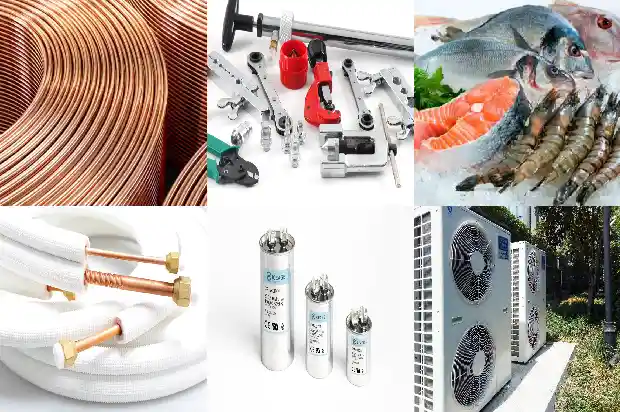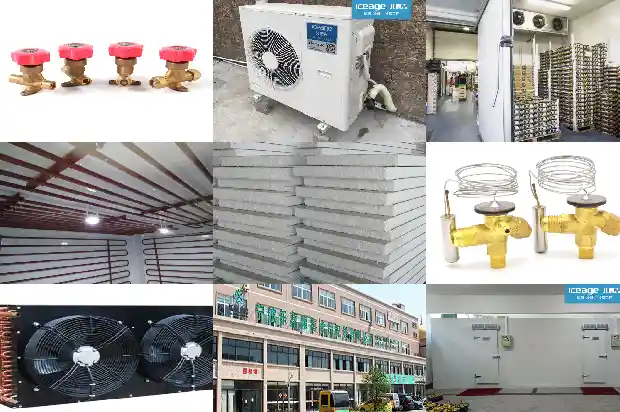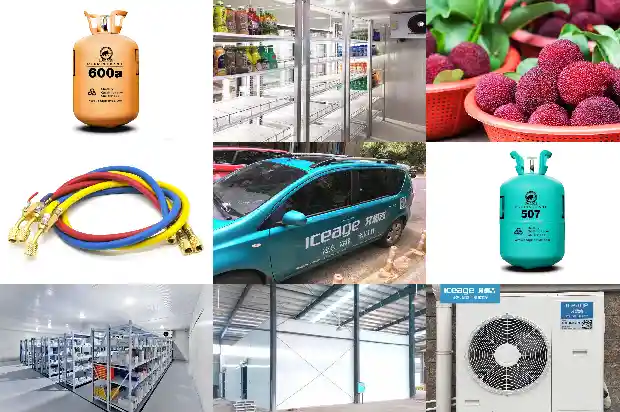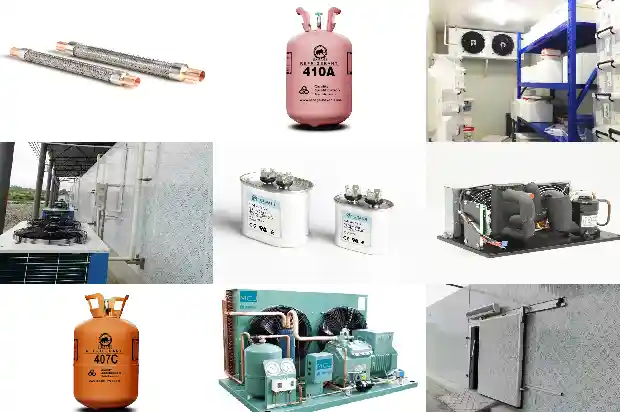What Are the Commonly Used Refrigerants in Refrigerators and Cold Storages?
2025-03-09
Refrigerants, also known as refrigeration working media, are the working substances in the refrigeration cycle. They are also called refrigerants, coolants, and refrigerants. They are the medium substances through which energy conversion is completed in various heat engines. Currently, there are more than 80 substances that can be used as refrigerants. Do you know what refrigerants are commonly used in refrigerators and cold storages respectively?
Common Refrigerants for Refrigerators
Previously, the most common refrigerant in refrigerators was R12. In the middle and late 1920s, the production volume of R12 reached its peak. In 2010, the global use of R12 was completely banned. In September 2010, China issued the "List of Controlled Ozone-depleting Substances in China", and the use of Freon and its derivatives (R11, R22, R113, etc.) was completely prohibited.
Currently, the main new refrigerants used in refrigerators are R134a, R600a, and the azeotropic refrigerant of R152a/R22, with their respective characteristics as follows:
Previously, the most common refrigerant in refrigerators was R12. In the middle and late 1920s, the production volume of R12 reached its peak. In 2010, the global use of R12 was completely banned. In September 2010, China issued the "List of Controlled Ozone-depleting Substances in China", and the use of Freon and its derivatives (R11, R22, R113, etc.) was completely prohibited.
Currently, the main new refrigerants used in refrigerators are R134a, R600a, and the azeotropic refrigerant of R152a/R22, with their respective characteristics as follows:
- Refrigerant R134a for Refrigerators
The standard evaporation temperature of R134a is -26.5°C, and the freezing point is -101°C, belonging to a medium-temperature refrigerant. Its properties are similar to those of R12: colorless, odorless, non-toxic, non-flammable, and non-explosive; the latent heat of vaporization is larger than that of R12, and it is immiscible with mineral lubricating oil, so polyester synthetic oil (such as polyolefin glycol) must be used; it is incompatible with nitrile rubber, and the sealing elements must be replaced with polybutadiene nitrile rubber; it has strong water absorption and is prone to reacting with water to form acids, which corrode the refrigeration pipeline and compressor. Therefore, there are high requirements for the dryness of the system, and the insulation grade of the compressor coil and insulation materials must be enhanced; the breakdown voltage and dielectric constant are lower than those of R12; the thermal conductivity is about 30% higher than that of R12; the corrosion and leakage properties to metal and non-metal materials are the same as those of R12.
R134a has no destructive effect on the atmospheric ozone layer, but it still has a certain greenhouse effect (the GWP value is about 0.27). Currently, it is one of the alternative working media for R12.
- Refrigerant R600a for Refrigerators
The standard evaporation temperature of R600a is -11.7°C, and the freezing point is -160°C, belonging to a medium-temperature refrigerant.
It has no destructive effect on the atmospheric ozone layer, no greenhouse effect, and is non-toxic, but it is flammable and explosive. Therefore, for the refrigeration pipeline where R600a exists, gas welding or electric welding is not allowed; it is easily miscible with mineral oil; it has a large latent heat of vaporization, so the system charging amount is small, and the price is low. The refrigeration capacity per unit volume is only about 50% of that of R12; it has high thermal conductivity and a small compression ratio, which plays an important role in improving the gas delivery coefficient and efficiency of the compressor; the working pressure is low, and the evaporation pressure at low temperatures is lower than the atmospheric pressure, increasing the possibility of inhaling air.
Due to the excellent environmental characteristics of R600a, which causes no pollution to the atmosphere at all, it is currently widely used as one of the alternative working media for R12. When R600a is used in refrigerators, the electrical components should be of explosion-proof type to avoid generating sparks. Therefore, there is a yellow flame safety mark on the compressor, and a non-contact PTC starting element is used.
The defrosting system (for frost-free refrigerators) can adopt the resistive contact heating method to make its surface temperature much lower than the combustion temperature of R600a (494°C). The compressor must be a special compressor suitable for R600a. The refrigeration capacity per unit volume of R600a is lower than that of R12, requiring the displacement of the compressor to be increased by at least one time. The test results show that compared with R12, its power consumption is reduced by about 12%, and the noise is reduced by about 2dB(A). If the refrigerant in the refrigerator's refrigeration pipeline is R600a, replacing it with R12 will cause the return gas pressure to rise, the compressor to overheat, and the high pressure to be too high, shortening the service life of the compressor and making it easily damaged. Therefore, R12 and R600a are not allowed to be replaced, so this replacement method should not be adopted.

- Azeotropic Refrigerant of R152a/R22 for Refrigerators
The azeotropic refrigerant of R152a/R22 is flammable and is universal with the R12 refrigeration system. After replacement, no major changes are required for the original refrigeration system. Leakage has little impact on the composition of the azeotropic refrigerant of R152a/R22. Under a mass fraction ratio of 50/50, the Ozone Depletion Potential (ODP) is 0.05, and the Global Warming Potential (GWP) is 105, both of which are within the acceptable range. After selecting an appropriate ratio, it has excellent thermal performance, a fast cooling speed, and a slight decrease in power consumption.
Common Refrigerants for Cold Storages
- Ammonia - for Large Cold Storages
Ammonia is currently one of the most widely used medium-pressure and medium-temperature refrigerants. The freezing temperature of ammonia is -77.7°C, and the standard evaporation temperature is -33.3°C.
Advantages: It is easy to obtain, low in price, has a moderate pressure, a large unit refrigeration capacity, a high heat release coefficient, and a small flow resistance.
Disadvantages: It has a pungent odor, is toxic, can burn and explode, and has a corrosive effect on copper and copper alloys. - Freon-22 (Code: R22) - Suitable for Most Cold Storages
R22 is also a halogenated alkane, with the scientific name of difluorochloromethane and the molecular formula of CHClF2. The standard evaporation temperature is about -41°C, and the freezing temperature is about -160°C.
Advantages: The condensing pressure is similar to that of ammonia, and the standard refrigeration capacity per unit volume is about 454 kcal/m³. It is widely used in two-stage compression or air-conditioning refrigeration systems at -40°C to -60°C.
Disadvantages: It has a destructive effect on the ozone layer and has a greenhouse effect. China will also completely phase out and ban its use in 2030. - Refrigerant R-404A - for Small Low-temperature Cold Storages
Chemical Composition of Refrigerant R-404A: It is a mixture of pentafluoroethane/trifluoroethane/tetrafluoroethane. Physical and Chemical Properties: R404A is a chlorine-free azeotropic refrigerant mixture. It is a colorless gas under normal temperature and pressure, and it is a compressed liquefied gas stored in a steel cylinder.
Advantages: It is an environmentally friendly refrigerant that does not damage the atmospheric ozone layer. It is mainly used to replace R22 and has the characteristics of being clean, low-toxic, non-flammable, and having a good refrigeration effect. It is widely used in medium and low-temperature refrigeration systems.
Disadvantages: The production cost is high, and the price is relatively expensive.
According to statistics, cold storages built before the 1980s currently account for about half of the total cold storage capacity in the country, and most of these cold storages have a service life of more than 30 years. However, many enterprises have failed to recover the funds for major overhauls of cold storages in a timely and sufficient manner, resulting in many cold storages being in disrepair for a long time. In some cold storage refrigeration systems, there is even a leakage of ammonia refrigerant, leading to many major safety accidents. Therefore, in the daily operation of cold storages, it is necessary to pay attention to daily inspections, record data such as pressure and temperature regularly, and conduct safety inspections regularly, especially the detection of various items of special pressure-bearing equipment.
Related Articles
- Types of Refrigerants and Leak - detection Methods
- Four Combustible and Explosive Refrigerants: Precautions When in Use!
- Scheme for the Use and Safety of Ammonia Refrigerants
- Introduction to the Relationship between Refrigerants and Cold Storage Temperatures
- Four types of flammable and explosive refrigerants
- Performance of Eco-friendly Refrigerants 410A and R407C
- The characteristics and uses of 26 types of air conditioning refrigerants
- Technical quality requirements for refrigerators after repair
- Explosion-Proof Refrigerators' Special Characteristics
- Conditions are Required for the Construction of Small - sized Cold Storages
- Characteristics of Mini Cold Storages in Cold Storage Projects
- Differences Between Steel Structure Cold Storages and Multi-story Civil Engineering Cold Storages
- Steps for Building Logistics Cold Storages
- Some Simple Troubleshooting for Combined Cold Storages
- Temperature Requirements for Various Cold Storages
- Daily Maintenance Training for Users after Installation of Small and Medium-Sized Cold Storages
- Types and Temperature Requirements of Seed Cold Storages
- Principle of Multiple Storages in One Unit and Evaporation Pressure Regulation Methods
